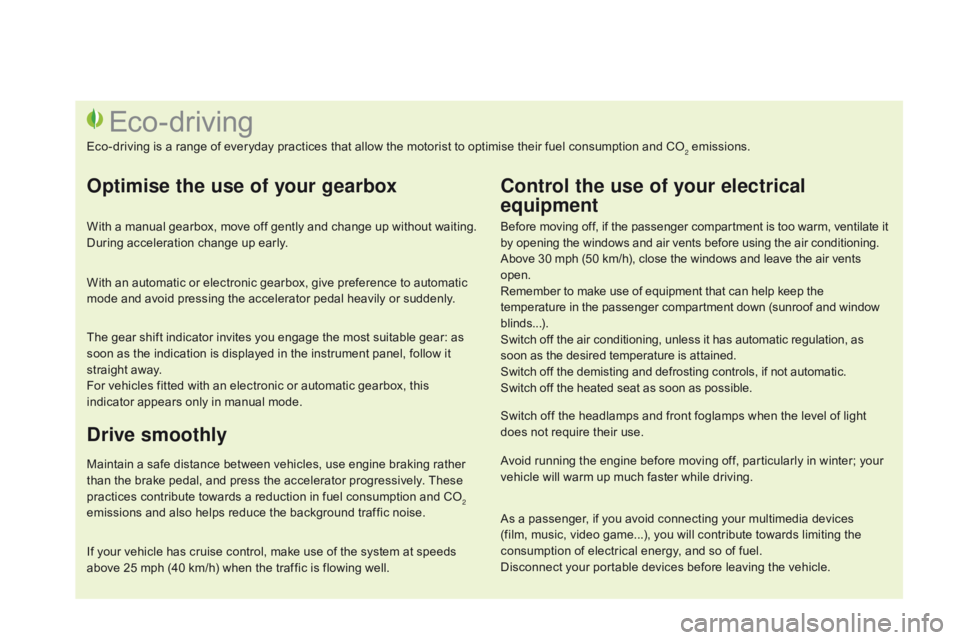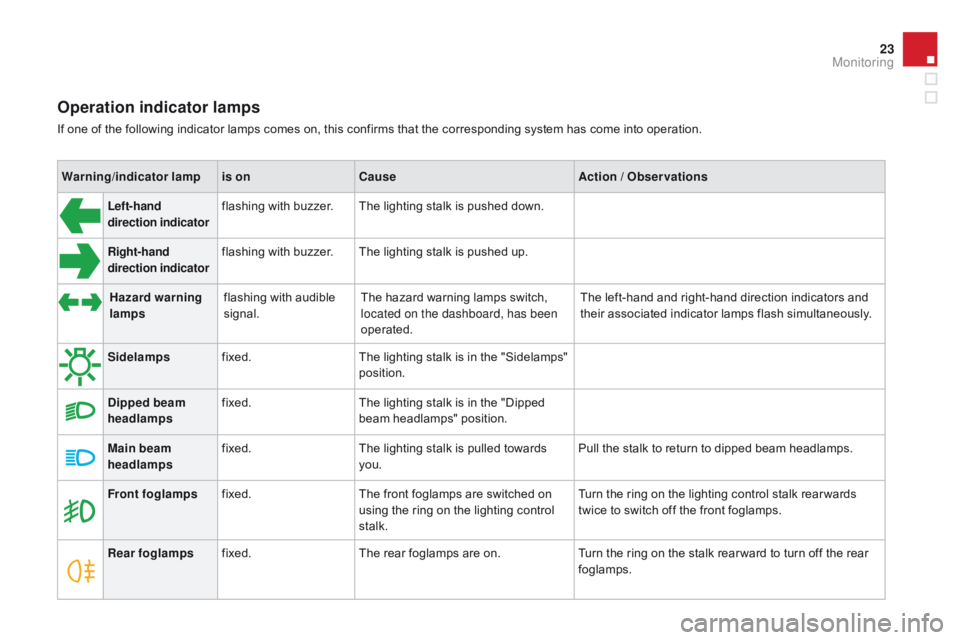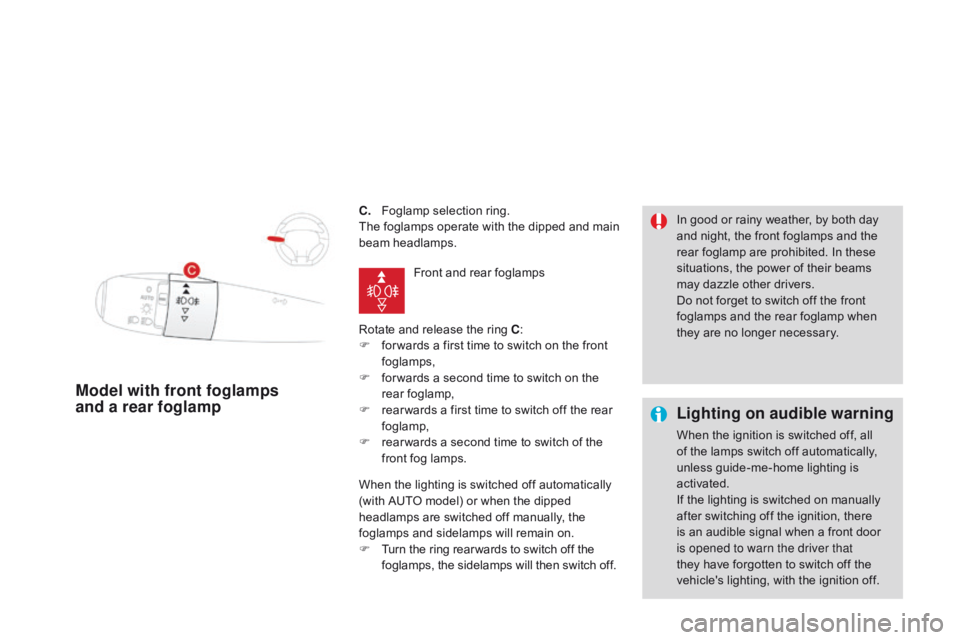fog light CITROEN DS3 CABRIO DAG 2015 Handbook (in English)
[x] Cancel search | Manufacturer: CITROEN, Model Year: 2015, Model line: DS3 CABRIO DAG, Model: CITROEN DS3 CABRIO DAG 2015Pages: 404, PDF Size: 13.93 MB
Page 16 of 404

DS3_en_Chap00c_eco-conduite_ed01-2014
Before moving off, if the passenger compartment is too warm, ventilate it by opening the windows and air vents before using the air conditioning.
Above
30 mph (50 km/h), close the windows and leave the air vents
ope
n.
Remember
to make use of equipment that can help keep the
t
emperature in the passenger compartment down (sunroof and window
b
linds...).
Switch
off the air conditioning, unless it has automatic regulation, as
s
oon as the desired temperature is attained.
Switch
off the demisting and defrosting controls, if not automatic.
Switch
off the heated seat as soon as possible.
Switch
off the headlamps and front foglamps when the level of light
d
oes not require their use.
Avoid
running the engine before moving off, particularly in winter; your
v
ehicle will warm up much faster while driving.
Eco-driving
Eco-driving is a range of everyday practices that allow the motorist to optimise their fuel consumption and CO2 emissions.
Optimise the use of your gearbox
With a manual gearbox, move off gently and change up without waiting. During acceleration change up early.
With
an automatic or electronic gearbox, give preference to automatic
m
ode and avoid pressing the accelerator pedal heavily or suddenly.
The
gear shift indicator invites you engage the most suitable gear: as
s
oon as the indication is displayed in the instrument panel, follow it
s
traight away.
For
vehicles fitted with an electronic or automatic gearbox, this
i
ndicator appears only in manual mode.
drive smoothly
Maintain a safe distance between vehicles, use engine braking rather than the brake pedal, and press the accelerator progressively. These
p
ractices contribute towards a reduction in fuel consumption and CO
2
emissions
and
also
helps
reduce
the
background
traffic
noise.
control the use of your electrical
equipment
If your vehicle has cruise control, make use of the system at speeds a bove 25 mph (40 km/h) when the traffic is flowing well.As
a passenger, if you avoid connecting your multimedia devices
(
film, music, video game...), you will contribute towards limiting the c
onsumption of electrical energy, and so of fuel.
Disconnect your portable devices before leaving the vehicle.
Page 25 of 404

23
DS3_en_Chap01_controle-de-marche_ed01-2014
Operation indicator lamps
If one of the following indicator lamps comes on, this confirms that the corresponding system has come into operation.
W arning /indicator lampis on
cau
seAction / Observations
Left-hand
direction indicatorflashing with buzzer.The lighting stalk is pushed down.
Right-hand
direction indicatorflashing with buzzer.The lighting stalk is pushed up.
Sidelamps fixed. The
lighting stalk is in the "Sidelamps"
p
osition.
di
pped beam
headlamps fixed.
The
lighting stalk is in the "Dipped
b
eam headlamps" position.
Main beam
headlamps fixed.
The
lighting stalk is pulled towards
yo
u. Pull
the stalk to return to dipped beam headlamps.
Front foglamps fixed. The
front foglamps are switched on
u
sing the ring on the lighting control
st
alk. Turn
the ring on the lighting control stalk rear wards
t
wice to switch off the front foglamps.
Rear foglamps fixed. The
rear foglamps are on.Turn
the ring on the stalk rear ward to turn off the rear
fo
glamps.
Hazard warning
lamps
flashing
with audible
s
ignal. The
hazard warning lamps switch,
l
ocated on the dashboard, has been
operated. The
left-hand and right-hand direction indicators and
t
heir associated indicator lamps flash simultaneously.
Monitoring
Page 134 of 404

DS3_en_Chap07_visibilite_ed01-2014
Lighting controlsSystem for selection and control of the various front and rear lamps providing the vehicle's lighting.
T he various front and rear lamps of the vehicle
a
re designed to adapt the driver's visibility
p
rogressively according to climatic conditions:
-
s
idelamps, to be seen,
-
d
ipped beam headlamps to see without
d
azzling
o
ther
d
rivers,
-
m
ain beam headlamps to see clearly when
t
he road is clear.
Main lighting
Other lamps are installed to fulfil the requirements of particular conditions of
v
isibility:
-
a
rear foglamp to be seen from afar,
-
f
ront foglamps for improved vision,
-
L
ED lamps to be seen during the daytime.
Additional lighting
Various automatic lighting control modes are also available according to the following
op
tions:
-
g
uide-me-home lighting,
-
a
utomatic illumination of headlamps.
Programming
In some weather conditions (e.g. low temperature or humidity), the presence
o
f misting on the internal sur face of the
g
lass of the headlamps and rear lamps
i
s normal; it disappears after the lamps
h
ave been on for a few minutes.
Page 136 of 404

DS3_en_Chap07_visibilite_ed01-2014
c. Foglamp selection ring.
The foglamps operate with the dipped and main
b
eam
h
eadlamps.
Rotate
and release the ring c
:
F
f
or wards a first time to switch on the front
fo
glamps,
F
f
or wards a second time to switch on the
r
ear
fo
glamp,
F
r
ear wards a first time to switch off the rear
fo
glamp,
F
r
ear wards a second time to switch of the
f
ront fog lamps.
Model with front foglamps
and a rear foglamp Lighting on audible warning
When the ignition is switched off, all o
f the lamps switch off automatically,
u
nless guide-me-home lighting is
a
ctivated.
If
the lighting is switched on manually
a
fter switching off the ignition, there
i
s an audible signal when a front door
i
s opened to warn the driver that
they
have forgotten to switch off the
v
ehicle's lighting, with the ignition off.
In
good or rainy weather, by both day
a
nd night, the front foglamps and the
r
ear foglamp are prohibited. In these
s
ituations, the power of their beams
m
ay dazzle other drivers.
Do not forget to switch off the front
f
oglamps and the rear foglamp when
t
hey are no longer necessary.
Front
and
rear
foglamps
When
the
lighting
is
switched
off
automatically
(
with
AUTO
model)
or
when
the
dipped
h
eadlamps
are
switched
off
manually,
the
f
oglamps
and
sidelamps
will
remain
on.
F
T
urn
the
ring
rear wards
to
switch
off
the
f
oglamps,
the
sidelamps
will
then
switch
off.
Page 138 of 404

DS3_en_Chap07_visibilite_ed01-2014
The sidelamps and dipped beam headlamps are switched on automatically, without any
a
ction on the part of the driver, when a low level
of
external light is detected or in certain cases
o
f activation of the windscreen wipers.
As
soon as the brightness returns to a
s
ufficient level or after the windscreen wipers
are
switched off, the lamps are switched off
au
tomatically.
Automatic illumination of headlamps
Activation
F Turn ring to the "AUTO" position. The a
utomatic illumination of headlamps is
a
ccompanied by a message in the screen.
deactivation
F Turn ring to a position other than "AUTO". D
eactivation is accompanied by a message
i
n the screen.
Association with the automatic
"Guide-me-home" lighting
Association with the automatic illumination of headlamps provides "guide-me-home" lighting
w
ith the following additional options:
-
s
election of the lighting duration to 15,
30 or 60 seconds in the functions that can
be
set in the vehicle configuration menu
(
except in the case of the monochrome
s
creen A, for which the duration is set:
60 seconds),
-
a
utomatic activation of "guide-me-home"
l
ighting when automatic illumination of
h
eadlamps is in operation.
Operating fault
In the event of a fault with the
sunshine sensor, the lighting
c
ome
on,
this warning lamp is displayed in the
i
nstrument
panel and/or a message appears in
t
he
screen,
accompanied by an audible signal.
Contact a CITR
oË
N dealer or a qualified
workshop.
In
fog or snow, the sunshine sensor
m
ay
detect sufficient light. Therefore,
t
he
lighting will not come on
au
tomatically.
Do not cover the sunshine sensor,
coupled with the rain sensor and
located in the centre of the windscreen
behind
the rear view mirror; the
a
ssociated functions would no longer
be c
ontrolled.
Page 219 of 404

217
DS3_en_Chap10_info-pratiques_ed01-2014
changing main beam headlamp bulbschanging sidelamp bulbs
F Remove the protective cover by pulling the t
ab.
F
D
isconnect the bulb connector.
F
S
pread the springs to release the bulb.
F
R
emove the bulb and change it.
To refit, carry out these operations in reverse
o r d e r. F
R emove the protective cover by pulling the t
ab.
F
P
ull the bulb holder pressing on the tabs on
bo
th
s
ides.
F
P
ull the bulb and change it.
To refit, carry out these operations in reverse
o r d e r.
LEd* / Xenon front lamps
* LED: light-emitting diode.
1.
di
rection indicators (LE
ds
).
2.
S
idelamps (LE d s).
3.
di
pped beam headlamps (Xenon).
4.
M
ain beam headlamps (LE
ds / Xe
non).
5.
da
ytime running lamps (LE d s).
6.
F
ront foglamps (PSX24W).
For replacements on of these types of lamps
(
LED / Xenon), contact a CITROËN dealer or a
q
ualified
w
orkshop.
Practical information